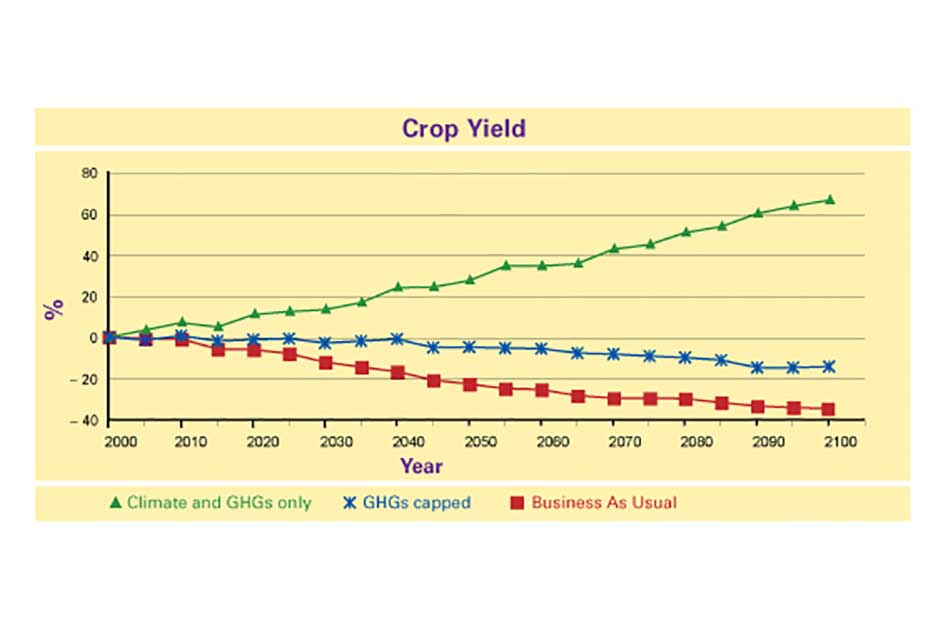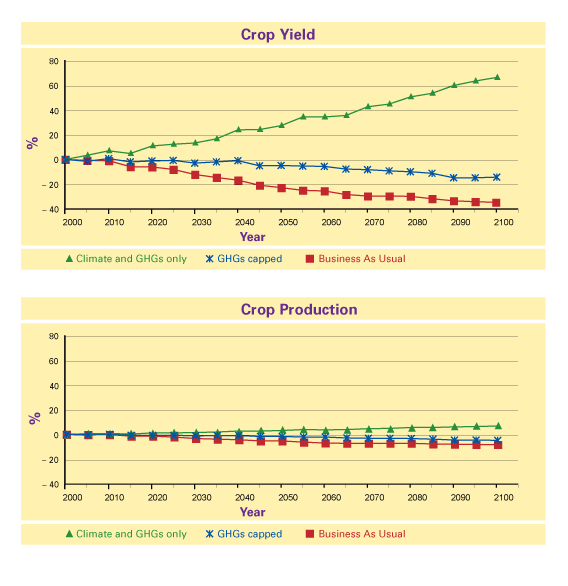
A new MIT study concludes that changes in the environment caused by increasing fuel use may damage global vegetation, resulting in serious costs to the world’s economy.
The analysis, reported in the November 2007 issue of Energy Policy, shows that increases in temperature and in carbon dioxide (CO2) may actually benefit crops, pastures, and forests. However, those benefits may be more than offset by the detrimental effects of increases in ozone, notably on crops.
The economic cost of the damage will be moderated by changes in land use and by agricultural trade, with some regions more able to adapt than others. But the overall economic consequences will be considerable.
Among the most striking results of the study is the difficulty of controlling ozone levels. “Even assuming that best-practice technology [for controlling ozone] is adopted worldwide, we see rapidly rising ozone concentrations in the coming decades,” said John M. Reilly, associate director for research of the MIT Joint Program on the Science and Policy of Global Change. “That result is both surprising and worrisome.”
The MIT study is novel in design and methodology. While others have looked at how changes in climate and in CO2 concentrations may affect vegetation, Reilly and his coworkers from the Joint Program and the Marine Biological Laboratory added to that mix changes in tropospheric ozone. Moreover, they looked at all three environmental “stressors” at once, examining their combined impacts on crops, pasture, and forests. (Changes in ecosystems and human health and other impacts of potential concern are outside the scope of this study.)
They performed their analysis using the MIT Integrated Global Systems Model, which combines linked state-of-the-art economic, climate, and agricultural computer models to project emissions of greenhouse gases and ozone precursors based on human activity and natural systems.
Expected and unexpected findings
Results for the impacts of climate change and rising CO2 concentrations (assuming business as usual [BAU], with no emissions restrictions) brought few surprises. For example, the estimated temperature increase — 2.75 degrees C by 2100 — would benefit vegetation in much of the world, as would the fertilization effect of rising CO2.
The effects of ozone are decidedly different. Even though new, cleaner technologies are deployed, ozone concentrations increase due to the scale of the economy and the projected increase in fuel use. In the BAU case, global average ozone goes up by 50 percent by 2100.
That increase will have a disproportionately large impact on vegetation because in many locations even relatively small increases in ozone concentrations raise them above the critical level where adverse effects are observed in plants and ecosystems.
Crops are hardest hit. Model predictions show that ozone levels tend to be highest in regions where crops are grown. In addition, crops are particularly susceptible to ozone damage because they are fertilized. “When crops are fertilized, their stomata open up, and they suck in more air. And the more air they suck in, the more ozone damage occurs,” said Reilly. “It’s a little like going out and exercising really hard on a high-ozone day.”
What is the net effect of the three environmental changes? In the BAU case, yields from forests and pastures decline slightly or even increase because of the climate and CO2 effects. But crop yields fall by nearly 40 percent worldwide.
However, those yield losses do not translate directly into losses in food production. According to the economic model, the world adapts by allocating more land to crops to keep food production up. Even where crop yields go down by as much as 60 percent, the production loss is no more than 8 percent. That adaptation, however, comes at a cost. The use of additional resources brings a global economic loss of 10-12 percent of the total value of crop production.

The upper figure shows MIT projections of global average percentage change in crop yield under three scenarios. In the highest curve, emissions of carbon dioxide (CO2) and other greenhouse gases (GHGs) are unregulated, and any impact of ozone is excluded. In the lowest curve, GHGs are unregulated, and crop damage from ozone is included. In the middle curve, GHGs are regulated, and ozone damage is included. The message: rising temperatures and CO2 concentrations cause crops to thrive (top curve), but that positive effect is more than offset by the negative impacts of rising ozone concentrations (bottom curve). When GHG emissions are regulated, fuel combustion declines, reducing ozone concentrations and related crop damage (middle curve). The lower figure shows changes in total crop production under the same three scenarios. While crop yields may drop dramatically, crop production never declines by more than 8 percent because the world adapts by allocating more resources to growing food.
The regional view
Global estimates do not tell the whole story, however, as regional impacts vary significantly.
For example, northern temperate regions generally benefit from climate change because higher temperatures extend their growing season. However, the crop losses associated with high ozone concentrations will be significant. In contrast, the tropics, already warm, do not benefit from further warming, but they are not as hard hit by ozone damage because ozone-precursor emissions are lower in the tropics.
The net result: regions such as the United States, China, and Europe would need to import food; and supplying those imports would be a benefit to tropical countries.
Such results emphasize the value of the MIT approach. “This is the first time, I think, that people have linked a multi-stress analysis to an economic model taking into account adaptation and international trade,” Reilly said.
Reilly warns that the study’s climate projections may be overly optimistic. The analyses to date use a two-dimensional climate simulation, which may not generate sufficiently detailed results to capture regional impacts, notably drought. The researchers are now incorporating a more realistic climate simulation into their analysis.
This research was supported by the Department of Energy, the Environmental Protection Agency, the National Science Foundation, NASA, the National Oceanographic and Atmospheric Administration, and the MIT Joint Program on the Science and Policy of Global Change.
This article appears in the Winter 2008 issue of Energy Futures.
Press inquiries: miteimedia@mit.edu